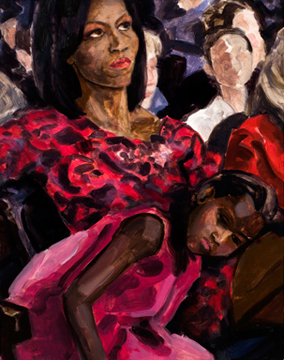
Two big attractions of the season—Carsten Höller’s hotel room and Pipilotti Rist’s video (see my Dec. 2 and 3 posts)—occupy a serious amount of space in their respective museums. A third, Elizabeth Peyton’s portrait of Michelle and Sasha Obama at the New Museum of Contemporary Art, is tiny but carried much intrigue when it was unveiled on November 5th. To a flurry of press coverage, Michelle and Sasha Obama listening to Barack Obama at the Democratic National Convention August 2008 joined portraits of Peyton’s friends, lovers and idols in the painter’s retrospective, Live Forever.When I visited this late addition to the show, I was surprised to find that the painting had its own security detail. Or at least that’s what it looked like. In fact, the hovering guard was waiting for some contractors and soon disappeared, ruining my fantasy that the piece was so portentous that it needed special protection. Truth was, I wanted to be more impressed by the painting than I was.
Though the portrait was surely meant as a tribute, it is anything but flattering. Notably, Peyton chose to emphasize a puffiness around Obama’s mouth, reversing her usual practice of prettying up her subjects (take, for instance her 1994 version of Ludwig II of Bavaria who, with hair flying, red lips pursed and a distant dreamy gaze, is more fashionista than monarch). In the same gallery, a portrait of a harrowed-looking Matthew Barney suggest a modern day, tortured Van Gogh character via which his expression and surroundings. But while the layered line and color on Barney’s face give him a weathered gravitas, the same technique leaves Obamas’ features streaky. Maybe Kehinde Wiley can give Peyton a lesson in depicting a range of skin tones, though it probably won’t be necessary since the closest she normally comes to portraying diversity is painting her partner in an afro wig.
Michelle Obama’s character continues to be the subject of national debate, but Peyton gives the future first mother and first lady an ambiguous expression that is simultaneously bored and tired though infused with a glint of excitement. Likewise, it’s unclear what Peyton had in mind with Obama’s pose, which seems too casual for the momentous occasion. During a moment of high energy, the family looks wiped out, which may indicate their sacrifice, but not much more. Of course, Peyton is painting not from life or the experience of meeting her subject, but from appropriated news footage. But her distance, even her lack of apparent enthusiasm, keeps the painting from being persuasive political art much less portraiture. Its understatement is the antithesis of the elation or disappointment felt by the nation on November 5.
What do you think of the painting? Is it good political art? Will we even remember it in a year or two? Post a comment.